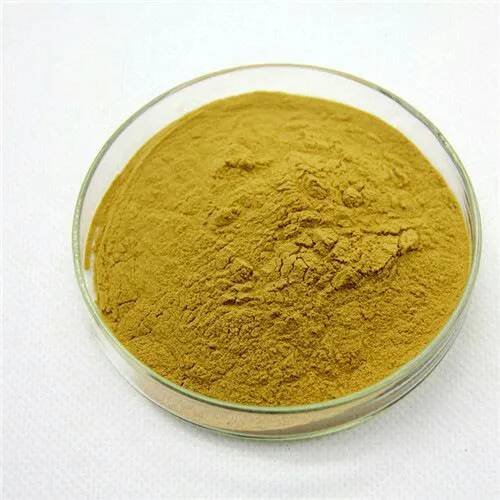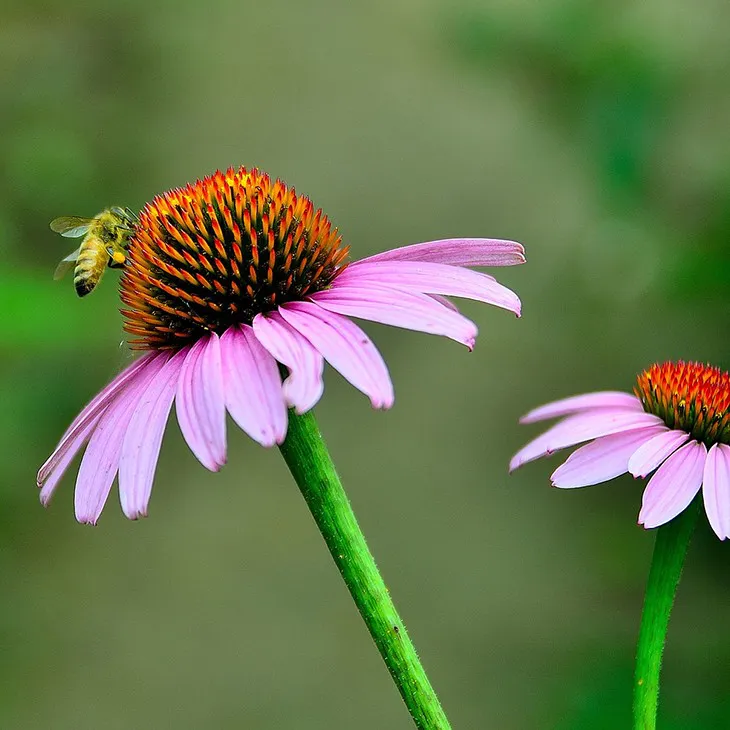- 0086-571-85302990
- sales@greenskybio.com
How to Extract Echinacea Extract by Steam Distillation.
2024-11-28

1. Introduction
Echinacea is a well - known plant with potential medicinal properties. Extracting its essence through steam distillation can be a valuable process for various applications in the fields of medicine, cosmetics, and herbal remedies. This article will provide a comprehensive guide on how to perform this extraction process effectively.

2. Selection of Echinacea Materials
2.1 Quality Considerations
- When selecting Echinacea plants, it is crucial to choose high - quality specimens. Look for plants that are healthy, free from diseases and pests. Diseased or pest - ridden plants may contain harmful substances or have a lower concentration of the desired active compounds.
- The growth stage of the plant also matters. Generally, plants at the appropriate maturity level are preferred. For Echinacea, it is often best to harvest when the flowers are fully developed but not yet starting to wilt.
- Wild - harvested Echinacea should be sourced ethically and legally. In many areas, there are regulations regarding the collection of wild plants to protect the ecosystem and ensure sustainable use.
- Cultivated Echinacea can be a more reliable source. It allows for better control over growing conditions, such as soil quality, irrigation, and fertilization. This can result in more consistent quality of the plants used for extraction.

3. Setup for Steam Distillation
3.1 Equipment Needed
- Steam generator: This is the source of steam for the distillation process. It should be capable of providing a consistent supply of steam at the required pressure.
- Distillation flask: The Echinacea material is placed in this flask. It should be made of heat - resistant glass or other suitable materials. The size of the flask depends on the amount of Echinacea to be distilled.
- Condenser: The condenser is used to cool the steam - vapor mixture coming from the distillation flask, causing it to condense back into a liquid. There are different types of condensers available, such as water - cooled condensers.
- Receiver flask: This is where the condensed Echinacea Extract is collected. It should be clean and sterile to prevent contamination of the extract.
- Tubing: Connects different parts of the distillation setup. It should be made of heat - resistant and chemically inert materials to ensure the integrity of the distillation process.
- First, place the Echinacea material in the distillation flask. Do not overfill the flask to allow proper steam circulation.
- Connect the steam generator to the distillation flask using the appropriate tubing. Ensure a tight connection to prevent steam leakage.
- Attach the condenser to the distillation flask. The condenser should be set up in a way that allows for efficient cooling. For a water - cooled condenser, connect the water inlet and outlet tubes correctly.
- Position the receiver flask at the end of the condenser to collect the condensed extract.

4. The Distillation Process
4.1 Temperature Control
- The temperature during steam distillation is a critical factor. The steam temperature should be carefully regulated to ensure efficient extraction without damaging the active compounds in Echinacea. Generally, a temperature range of around 100 - 110°C is often suitable for Echinacea distillation.
- Too high a temperature may lead to the degradation of some of the volatile compounds in Echinacea. On the other hand, if the temperature is too low, the extraction may be incomplete.
- Proper pressure control is also essential. Maintaining a stable pressure in the distillation system helps to ensure a consistent flow of steam through the Echinacea material. A slightly elevated pressure, usually within the range of 1 - 2 atmospheres, can enhance the extraction efficiency.
- Fluctuations in pressure can cause irregular steam flow, which may result in an inconsistent extraction quality.
- The distillation process typically takes several hours. The exact duration depends on various factors, such as the amount of Echinacea material, the efficiency of the equipment, and the desired concentration of the extract.
- During the distillation, it is important to monitor the process continuously. As the distillation progresses, the amount of extract collected in the receiver flask will gradually increase.

5. Post - Distillation Handling of the Extract
5.1 Purification
- After the distillation, the collected Echinacea Extract may contain impurities. One common purification method is filtration. Using a fine - mesh filter or filter paper, remove any solid particles that may be present in the extract.
- Another purification technique is centrifugation. This can be useful for separating heavier impurities from the extract. The extract is placed in a centrifuge tube and spun at a high speed to force the impurities to the bottom of the tube.
- The purified Echinacea Extract should be stored properly to maintain its quality. It is best stored in a dark, cool place. Exposure to light and heat can cause the degradation of the active compounds in the extract.
- Use amber - colored glass bottles for storage as they can block out most of the harmful light wavelengths. Seal the bottles tightly to prevent air and moisture from getting in, which can also affect the stability of the extract.
6. Conclusion
Steam distillation is a complex but effective method for extracting Echinacea extract. By carefully selecting the Echinacea materials, setting up the distillation equipment correctly, controlling the distillation process, and handling the extract properly after distillation, one can obtain a high - quality Echinacea extract. This extract can then be used in a variety of applications, contributing to the development of natural - based products in different industries.
FAQ:
What are the criteria for selecting high - quality Echinacea plants?
When selecting high - quality Echinacea plants, several factors need to be considered. Firstly, the plants should be in a healthy state without any signs of disease or pest infestation. They should have well - developed root systems and vigorous foliage. The age of the plant also matters; typically, plants at the appropriate growth stage are more suitable. Also, the origin of the plant can influence its quality. Plants grown in their native or suitable ecological environments are more likely to have better chemical compositions for extract production.
What equipment is needed for steam distillation of Echinacea extract?
For steam distillation of Echinacea extract, essential equipment includes a distillation flask. This is where the Echinacea materials are placed. A condenser is also necessary to cool the vapor back into liquid form. A heat source, such as a heating mantle, is used to provide the heat for the distillation process. Additionally, a receiving flask is needed to collect the distilled Echinacea extract. Tubes and connectors are used to properly assemble these components to ensure a sealed and efficient distillation system.
How important is temperature control during the steam distillation process?
Temperature control is extremely important during the steam distillation of Echinacea extract. The appropriate temperature ensures that the active compounds in Echinacea are effectively extracted without being degraded. If the temperature is too low, the distillation process may be slow and incomplete, resulting in a lower yield of the extract. On the other hand, if the temperature is too high, it may cause some of the volatile and valuable components to decompose or change chemically, thus affecting the quality of the final extract.
What are the methods for purifying the Echinacea extract after distillation?
After distillation, there are several methods for purifying the Echinacea extract. One common method is filtration. Using a fine - mesh filter or filter paper can remove solid impurities from the extract. Another method is solvent extraction. By using a suitable solvent, some unwanted substances can be separated from the extract. Additionally, chromatography techniques, such as column chromatography, can be used to further purify the extract by separating different components based on their chemical properties.
How should the Echinacea extract be stored after extraction?
The Echinacea extract should be stored properly after extraction to maintain its quality. It is best to store it in a dark, cool place to prevent exposure to light and heat, which can cause degradation of the active compounds. Using airtight containers, such as amber - colored glass bottles, can prevent oxidation and contamination. Additionally, it is advisable to store the extract at a consistent temperature and humidity level to ensure its long - term stability.
Related literature
- Steam Distillation Techniques for Herbal Extracts"
- "Optimizing Echinacea Extract Production: A Review"
- "The Chemistry and Extraction of Echinacea"
- ▶ Hesperidin
- ▶ citrus bioflavonoids
- ▶ plant extract
- ▶ lycopene
- ▶ Diosmin
- ▶ Grape seed extract
- ▶ Sea buckthorn Juice Powder
- ▶ Beetroot powder
- ▶ Hops Extract
- ▶ Artichoke Extract
- ▶ Reishi mushroom extract
- ▶ Astaxanthin
- ▶ Green Tea Extract
- ▶ Curcumin Extract
- ▶ Horse Chestnut Extract
- ▶ Other Problems
- ▶ Boswellia Serrata Extract
- ▶ Resveratrol Extract
- ▶ Marigold Extract
- ▶ Grape Leaf Extract
- ▶ blog3
- ▶ blog4
-
Nature's best vitamin D3.
2024-11-28
-
The best velvet antlers in 2024.
2024-11-28
-
Passionflower Extract
2024-11-28
-
Purple Sweet Potato Extract
2024-11-28
-
Red Date Extract
2024-11-28
-
Lily extract
2024-11-28
-
Red Vine Extract
2024-11-28
-
Lemon Juice Powder
2024-11-28
-
Clove Powder
2024-11-28
-
Chia Seed Powder
2024-11-28
-
Kidney Bean Extract
2024-11-28
-
Shikone Extract
2024-11-28





















